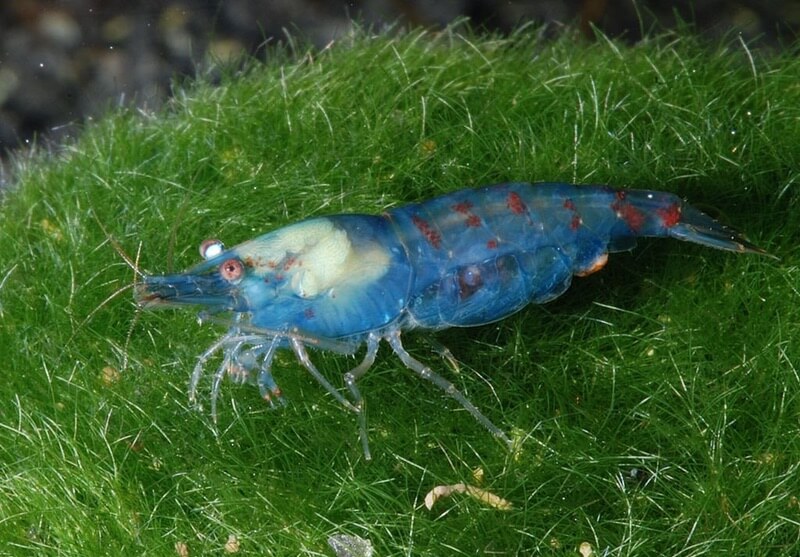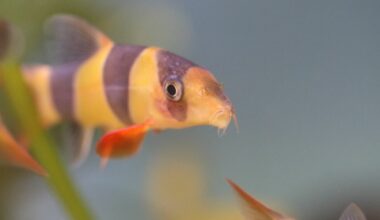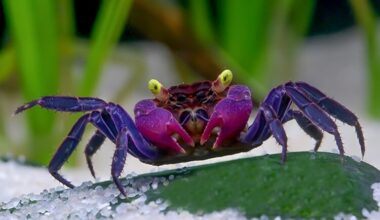Blue pearl shrimp are gorgeous freshwater critters that can thrive in a variety of conditions. Because of that, they’re a popular choice for aquarists who want to add some peaceful color to their tank!
This guide will teach you everything you need to know about these creatures, and how to care for them.
Table of Contents
Species Summary
The blue pearl shrimp (Neocaridina cf. zhangjiajiensis var. blue) is a unique addition to your tank’s cleanup crew. This dwarf shrimp species is a relatively new addition to the fish-keeping community. It’s a blue variation of Neocaridina cf. zhangjiajiensis that was initially bred in Germany.

Thanks to its pearly blue color, it quickly became a sought-after freshwater shrimp species to hobbyists worldwide! These inverts are docile and easy to care for in the right conditions. They have healthy appetites and will work alongside other algae-eaters to keep your tank clean.
Meanwhile, the turquoise coloration makes these shrimp stand out. Whether you have a heavily planted aquarium or one that uses rocks and modern decor, these beauties are a welcome addition.
Appearance
These creatures look similar to other dwarf shrimp species. They’re small, conical, and have sectioned tails. Lengthy antennae on the head help them navigate their surroundings, while tiny swimmerets move beneath them for motion.
The color of the shrimp is light blue, but there’s plenty of variation. Some shrimp will be almost pearl white or turquoise. The most valued shrimp are darker blue. In most cases, the more vibrant specimens are female.
Lifespan
Don’t expect to have these shrimp very long. The lifespan of most blue pearl shrimp is one to two years.
As always, the creature’s life expectancy depends on genetics and living conditions. You can’t do much to avoid genetic predispositions, but you can be vigilant about their habitat, water conditions, and diet. Proper care may extend life expectancy to help you get as much enjoyment from these beauties as possible.
Average Size
Blue pearl shrimp belong to the dwarf shrimp family. Juveniles are usually less than half an inch long. Adults will reach a little over an inch long at maturity.
Blue Pearl Shrimp Care
Blue pearl shrimp are some of the more accessible invertebrates to raise in captivity. They’re low-maintenance, undemanding, and peaceful. But as always, they have preferences.
Follow these blue pearl shrimp care guidelines if you want to provide them with the most comfortable life possible.
Tank Size
Blue pearl shrimp don’t require much space, thanks to their small stature.
They’re perfect for a single-species nano tank. However, the best results come with habitats that can hold at least 10 gallons.
A 10-gallon tank offers room to roam. It also gives you more flexibility in creating a natural environment conducive to the shrimp’s lifestyle.
Water Parameters
This dwarf shrimp species is highly adaptable. They do well in standard tropical water conditions. As a result, you shouldn’t have to adjust much to help these inverts thrive in established aquariums.
As long as you stick to the following water parameters, the shrimp will do just fine.
- Water Temperature: 68 to 80 degrees Fahrenheit (Around 75 degrees is ideal)
- pH level: 6.5 to 8.0 (Near-neutral conditions of 7.2 are best)
- Water hardness: 7 dKH or up to 20 dGH
What To Put Inside Their Tank
Here’s where you can get a bit more creative! Like water conditions, blue pearl shrimp aren’t demanding regarding aquarium decor. However, you can do a few things to enhance the shrimp’s life while making their color pop.
The first is to use a dark-colored substrate. The shrimp will spend most of their lives at the bottom of the aquarium. Dark-colored sand or earthy plant substrate makes the blue coloration stand out. Fine sand or something with a similar consistency is ideal for safety.
Plants aren’t a requirement, but they are ideal. Plants can dramatically improve water quality. They remove harmful contaminants, boost oxygenation, and give the shrimp plenty of places to hide. Plus, the plants can develop algae that the shrimp eat.
Get creative with your plant arrangement. These shrimp love density but leave open space, too.
Author Note: Don’t forget to use sponges on your filters! These shrimp are too weak for high-powered pumps and strong suction. Always use sponges to ensure that the shrimp aren’t sucked into your filters.
Potential Diseases
With blue pearl shrimp, water stability is the most important thing. Frequently check water parameters and test for ammonia and nitrates. High ammonia and nitrate levels can kill these shrimp surprisingly quickly.
While shrimp can’t get Ich like fish, the stress of poor water quality can take its toll. It makes the shrimp susceptible to bacterial infections that ultimately end their lives.
Change about 30 percent of the water every week. That way, you can keep ammonia and nitrate levels under control. It’s also important to wait until you have a fully cycled tank. Adding your blue pearl shrimp into an uncycled tank could spell disaster.
Food & Diet
These shrimp are small, but they have mighty appetites! Blue pearl shrimp will spend most of their time searching for food. They love to eat the algae that stick on plants and decor.
But make no mistake: The algae alone isn’t enough to keep the shrimp healthy. You must supplement their diet to ensure they get all the nutrients they need to thrive.
Any sinking pellets will work well as a staple for their diet. These inverts are omnivores, so they’re not picky. You can also provide blanched vegetables, winking algae wafers, and other similar items.
Behavior & Temperament
Aggression is not a concern with blue pearl shrimp. They pose no threats to other fish or inverts in the tank and rarely fight amongst one another.
They’re the epitome of a peaceful tank-dweller!
Tank Mates
The biggest challenge you’ll have with blue pearl shrimp care is figuring out what tank mates they can cohabitate with. Because they’re so small, Blue pearl shrimp frequently become the targets of hungry fish. Never keep them in the same tank as aggressive freshwater fish. These guys won’t stand a chance!
Your best bet is to keep the blue pearl shrimp with other nano invertebrates. That includes other dwarf shrimp species and peaceful snails. They also do well with docile algae eaters.
Here are some good choices if you want to include blue pearl shrimp in a community tank.
- Cherry shrimp
- Malaysian snail
- Ghost shrimp
- Otocinclus
- Small rasboras
- Guppies
- Endler’s livebearers
- Ember tetra
Breeding
Breeding blue pearl shrimp is easy. The only requirements are to have a male shrimp and a female shrimp in a well-maintained tank. The shrimp will do the rest!
This species is a prolific breeder in captivity. Blue pearl shrimp spawn every two to three months. With each event, females lay about 30 eggs.
The babies emerge as miniature versions of the adults. Add plenty of plants to the tank before the shrimp gives birth. Plants maximize survival rates, providing the shrimplets with plenty of hiding spaces and algae to eat.
Conclusion
Blue pearl shrimp are easy to care for. As long as you’re prepared to offer them the baseline aquarium conditions they need to survive, these critters will do just fine.
If you have any questions about these shrimp that we didn’t cover, let us know!

